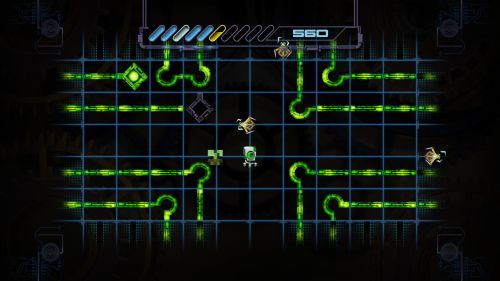

Action puzzlers like A Virus Named Tom are nothing new. People have been connecting conductive conduits since the days of Pipe Dream. Even Bioshock had these puzzle elements – placed under the guise of “hacking” computers. Whether it be pipes or computer circuits, the goal is largely the same: connect everything up so the water/electricity (spice) can flow. In the case of A Virus Named Tom (AVNT), you are the eponymous creation of an inventor that has recently been fired from the company for which he once created a multitude of useful devices. Slighting a potentially unstable genius? Not the wisest choice.
The main focus of the game is that, as TOM, you need to go through all of the inventions your creator once made and infect them to ensure their operation is short-lived. To achieve this, you’ll have to go circuit-by-circuit (level-by-level) and spread the infection. This starts off simple enough: turn a piece of circuitry here, watch the green glow move about, and victory is yours! For the first few levels, it’s just that straightforward.
Then AVNT takes a left turn and introduces some new challenges to thwart your schemes, like a “cryptographic” sequence that masks the circuit pieces so you can’t tell what you’re turning, or anti-virus programs that will temporarily disrupt your infectious ways. You’ll get some upgrades along the way, such as dropping glitches that disrupt the anti-viruses, that makes it easier to complete your sinister task. So, you can keep going through all 50 of the single-player levels and go about tickling the puzzle-solving center of your brain (located near the gooey chocolate center), or you can get a bit more competitive.
Anti-virus programs and circuitry running off the screen; just a few of the challenges you'll face on your infectious path
As you clear a circuit, you receive a score based off the amount of energy (i.e., “time it takes you to spread the infection”) you have left. This energy first serves two purposes: a “failure” mechanic (run out of energy and you fail the level), and to provide you with a score at the end of the level. Clear the level with a certain amount of energy remaining awards you a bronze, silver, or gold medal, which is solely for personal satisfaction, but you also get a score. The sheer genius (and it is an evil genius, to be sure) of this mechanic, though, is that once you notice the score aspect, you start paying attention to the leaderboard that just comfortably sits unobtrusively over on the right-hand side of the level select screen.
You notice your score sitting amongst your friends’ and the game developers’. “My score’s not that far off from the top, surely I can make it to No. 1,” you think. An idea has now infected your thinking (pun intended), and it’s a tough one to shake. “It’s all about efficiency of movement; I know how to solve the puzzle, but how I can solve it in the fewest number of moves, possible,” you’ll now ruminate quietly in the dark under the soft glow of the computer screen as the clock hands slowly tick to 3 AM. I am by no means a competitive person when it comes to games, but something about AVNT changed that. “I bet I could solve it faster with my friends…”
Two (or three or four) heads are better than one when it comes to solving the circuit puzzles, just be sure to work together
As I mentioned on the front-page, the best feature of the game is its cooperative gameplay – which should say something considering the magnificence of the single-player game. AVNT’s co-op mode is local only, so if you don’t have a gamepad controller, you and up to two of your friends will be crowding around the keyboard to control your respective TOMs through a combination of WADS, arrow keys, and numeric keypad. With a gamepad controller, that number bumps up to four. It all makes for an intimate co-op session, for sure, but also a fun one.
In co-op mode, a whole new set of levels (50 total here, too) open up that start off fairly simple and straightforward, and progressively get more challenging and require more cooperation from all players. The cooperative levels will occasionally toss a kind of electric barrier down the middle of the level that keeps a player on his or her respective side of things. So you may see the solution to the other player’s dilemma, but rather than just stroll over there and take care of it, you’ve got to communicate with them. Amidst the eventual chaos of an ever dwindling energy supply, anti-virus programs running around, and some other fun twists, successful communication of “turn that one clockwise… No, clockwise!” can be difficult. If you start shooting for the top spot on the leaderboard for the co-op level, well that’s going to add even more stress to the whole affair. There is nothing, though, like the synchronized movements of a group of players working as well-organized unit to clear a level, and striving for that level of perfection as a team certainly brings friends together.
Of course, you don’t have to always be cooperative when playing co-op. Two TOMs can’t occupy the same space at the same time, so there are plenty of opportunities to keep your friends from being able to escape from an anti-virus, or change one of their circuit pieces back to how it was (intentionally or accidentally). Fun natured griefing is certainly a part of co-op and AVNT provides you with plenty of chances to do so; again, whether intentionally or accidentally. When you get a group of friends into such a cramped space, it’s tough to avoid such incidents from occurring, and honestly, the game definitely wouldn’t be the same if it was missing. Sometimes, you’ve just got to teach your friends a lesson.
No chance for griefing here; like the song says, "gotta keep 'em separated"
Despite all these great things with AVNT, it is not without a flaw or two. The biggest flaw, when it comes to co-op, is the lack of any online play. Now this is a game that greatly benefits from local co-op for the reasons mentioned above. However, not having the option to play with your friends, who may not be quite so close to you, puts a bit of a damper on the fun. Interestingly, online co-op/multiplayer was something that the developers wanted to do, but just weren’t quite able to make it happen thanks to… two of the developers having a baby (babies: always demanding attention above all else). So, there is a possibility that such a feature could see its way into the game at some point. The only other flaw with the game is that many of the mechanics that are interesting and fun at first (such as the cryptographic covers or some of the later anti-virus programs), get a bit tiring after the 15th encounter with them. It’s an odd flaw, though, as it is more pronounced if you’re just playing through the game to complete it, than if you’re competing for the high score.
Between the game’s single-player mode, the cooperative mode, and the multiplayer vs mode (which essentially sees you competing with friends to see who can take over the most amount of grid space), there’s plenty to do and all of it is fun. This is in addition to a very fitting/catchy soundtrack and a wonderfully quirky sense of humor. It’s got a couple hitches that keep it from being a solid game, but it is easily a hearty recommendation to any and all puzzle fans out there. Now if you don’t mind, I gotta move my couch back into the living room…
A Virus Named Tom is available exclusively on PC (for now) through Steam and Desura. A review code of the game was provided by the developer.